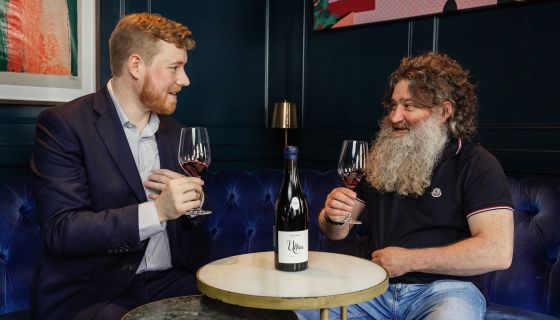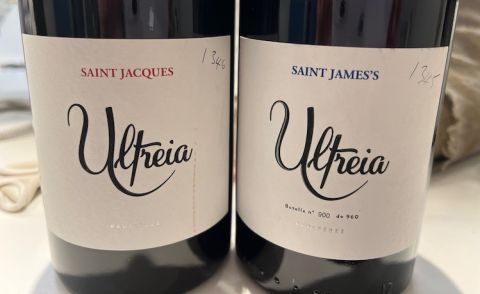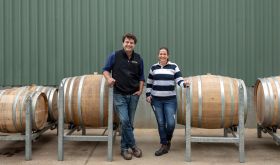From €8.90, $14.39, £14.68
Raúl Pérez is a magician – and you have to admit he does look like a bit of a wizard. That’s him on the right, above. He manages to create succulent wines of great character, initially in his native Bierzo and now further afield in the far north-west of Spain. He was first mentioned on these pages in 2009 and his Ultreia Saint Jacques 2008 was my wine of the week in 2010, where you can see a picture of him before he grew that beard.
His family have been vine growers in the village of Valtuille de Abajo for more than 300 years and eventually founded a winery, although Pérez now has his own burgeoning company. His deep knowledge of the region and its Mencía vines is second to none. Ultreia Saint Jacques is supposedly his entry-level Bierzo, a blend of wines produced from a combination of purchased and leased vineyards from all over the zone. But it is crackingly good quality – way above that suggested by the price. (Incidentally, I see that back in 2010 it was £50 for six bottles in bond in the UK and today is still only £120 for 12 in bond – so it hasn't risen much in price over the last 13 years.)
We have tasting notes on the last five vintages of Ultreia Saint Jacques as well as on the 2008. The wine has never been scored less than 16 and the last two vintages, 2019 and 2020, achieved scores of 17, even though this is a wine that can be found for under €9 a bottle in Spain and for just $14.39 in the US. It has been so successful that production is now about 400,000 bottles a year and he has built a special cellar devoted to producing it. (Ultreia Godello is its white stablemate.)
‘Saint Jacques is by far the most important wine I make', says Pérez. About 85% of the old vines that supply it are grown on clay with the rest on sand. The wine is fermented in traditional oak vats, some bought from world-famous Vega Sicilia in Ribera del Duero, and all but about 20% of the grapes are fermented as whole bunches. The must is kept in contact with the skins for a full two months before the wine is pressed into neutral barrels, where it’s aged for a further 10 months. Most of the grapes are the local Mencía but some field blends go into the blend so there are small proportions of Alicante Bouschet, Trousseau/Bastardo, Palomino and other varieties.
My tasting note on the Ultreia Saint Jacques 2020:
Transparent crimson. Thoroughly satisfying, complex, lifted perfume that already shows some integration even if quite a hit of acidity and a little tannin on the palate. It doesn't have the sweet majesty of Bierzo reds costing many times as much but is clearly an artisanal product. Refreshing and only medium body in terms of impact on the palate. VGV
And on the Ultreia Saint Jacques 2019, another vintage that is likely to be on sale currently:
Bright mid crimson. Really pure, polished fruit and a great, accessible expression of Mencía fruit. Attractive note of bitter cherries on the end. GV
Practically every decent wine shop in Spain seems to stock Ultreia Saint Jacques, along with well over 100 in the US, and you can also find it in France, the Netherlands, Luxembourg, Germany, Czechia ... indeed more countries than I can list here.
According to Pérez’s US importer Skurnik, ‘in addition to numerous other accolades, Raúl was named Winemaker of the Year by Der Feinschmecker in 2014 and Best Winemaker in the World by Bettane+Desseauve in 2015. Raúl would certainly not self-apply any of these superlatives. In fact, his genius is far exceeded by his humility and generosity of spirit. That humility comes through in his wines. These are not “winemaker” wines so much as they are unadulterated expressions of the villages and vineyards from which they hail.’
For some years smart wine merchant Justerini & Brooks has been Pérez's UK importer and their specialist buyer of Spanish wines Mark Dearing, on the left in the picture above, has just released a super-special Bierzo made from old vines in some of the best vineyards in the region.
Whereas Pérez’s well established bargain blend’s name, Ultreia Saint Jacques, was inspired by the name of the pilgrims’ trail (camino) that passes through the Bierzo region on the way to Santiago (Saint James in Spanish, Saint Jacques in French) de Compostela, Dearing and Perez’s joint-venture wine is named Ultreia Saint James’s, a reference to the London location of Justerini & Brooks (and, incidentally, their great rivals Berry Bros & Rudd as well as, more recently, the wine-themed members’ club 67 Pall Mall).
Although the two wines look disconcertingly similar (the pair I tasted are shown above with their full-bottle weights scribbled on the labels as is my habit), their prices and composition are very different. Dearing explains the background thus:
‘Our Saint James’s blend is from proper estate vineyards of which two-thirds come from single-vineyard quality parcels in Valtuille de Abajo, Raúl’s home village, in the historical centre of the region (warmer clay and sandy soils), and a third comes from a new area called Valdecanada. This is a cool, slate/schist-rich subregion above the town of Ponferrada with some of the highest, oldest and lowest-yielding vines in the whole Bierzo appellation. Raúl has bottled Valdecanada as a standalone project over the past five years or so and is slowly drip-feeding the wines out to a handful of importers (when not drinking them himself).
‘He has essentially recuperated the whole Valdecanada area after it largely lay abandoned due to its difficult location, marginal climate and low yields, so the Valdecanada wines now represent the most expensive in Raúl’s stable at about £65 for the village bottling and £150 for El Cerro. Moreover, La Vitoriana (Valtuille) is one of the best vineyards in the region and is only bottled as a single vineyard in both the La Vizcaina range (from the lower and middle of the slope) and under the Ultreia label (the best, oldest 0.3-ha plot at £100 per bottle – and represents the top Ultreia single vineyard).
‘Apart from La Vitoriana, which costs more, all of the Ultreia single-vineyard wines are now £52.68 per bottle. I think the Saint James’s blend is of similar quality and RP thinks it will age for 20 years. At £32.68 per bottle, it sits between the middle-tier La Vizcaina wines and the premium Ultreia single vineyards but is made up only of top sites, so I think represents very good value. (Cabanelas is bottled as a single-vineyard wine by Castro Ventosa – RP’s original family estate, where he is a consultant, so that is an old vineyard of repute also.)’
Whole-cluster fermentations are a Pérez trademark and in this case not a single grape was destemmed. This is the makeup of the blend:
45% Cabanelas (Valtuille de Abajo) – a 2-ha east-facing site, on clay-sand soils (similar to La Poulosa), planted 1930. 60 days on skins. Aged 15 months in a five-year-old 500-litre Rousseau barrel. A full, flattering, typically Valtuille component.
23% La Vitoriana (Valtuille de Abajo) – north-facing site at 600 m elevation on poor, stony soils. Planted in 1881 on original rootstocks. 90 days on skins. Aged in a five-year-old Sylvain 500-litre barrel. Brings acidity, red fruits and wiry tannins to the wine.
23% Valdecanada villages – blend of three parcels in the Valdecanada region at 750–850 m. Aged in the Ultreia cellar under a veil of flor (no sulphur additions until bottling), eight months skin contact in a large wooden ex-Vega Sicilia vat, then pressed into neutral barriques in June and aged for a further six months.
9% El Cerro (Valdecanada) – single Cara Norte vineyard planted on schist with a field blend of mainly Mencía but with some Palomino and Bastardo (Trousseau) too. 800 m elevation. Aged as for the Valdecanada village wine in a two-year-old 500-litre barrel that was discarded from the Valdecanada project. Darker fruit, high acidity – more concentrated and expansive.
My tasting note on this debut Ultreia Saint James’s 2020:
Transparent crimson – a little deeper than the Ultreia Saint Jacques 2020 bottling. A bit more mineral and smoky on the nose with more prominent tannins on the finish. Good, fresh acidity and bite. But this definitely needs food at this stage whereas I could imagine the Saint Jacques as what might be called a quaffing red. Bitter cherry flavours. Good, appetising, complex stuff with a real future ahead of it!
All wines discussed here have 13.5% on the label but Dearing assures me that his wine is actually only 12.2% alcohol. I reckon it should continue to evolve for many years whereas the Saint Jacques is probably best drunk in its first three years. Saint James's is clearly a fascinating, ambitious project. Its only ‘problem’ is that it looks so like another great (but much less ambitious) wine that costs so much less. Ultreia Saint James’s is £33.68 (£71.36 for a magnum) from Justerini & Brooks, or £155 for six bottles in bond. It is also available at Hedonism and therefore at the associated restaurant Hide in London. Justerinis have found a market for the wine at the new Duck & Waffle in the St James Quarter of Edinburgh too – but it shouldn’t be too difficult to sell the total production of this debut vintage of just 960 bottles.
Want more wine recommendations? Become a member to access more than 230,000 reviews, as well as expert advice and information on the world of wine.















